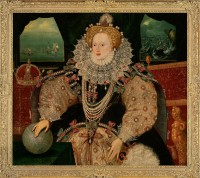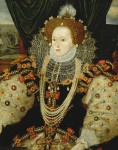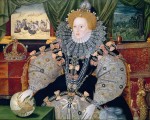 The Art Fund and Royal Museums Greenwich have launched a campaign to buy the iconic Armada Portrait of Queen Elizabeth I before it’s put up for public auction. The Art Fund has contributed £1 million ($1,461,000) and Royal Museums Greenwich £400,000 ($584,000), its entire annual acquisitions budget, but that’s just the tip of the iceberg. They need to raise another £8.6 million ($12,564,000) to secure the portrait for its asking price of £10 million or else it will be sold to the highest bidder.
The Art Fund and Royal Museums Greenwich have launched a campaign to buy the iconic Armada Portrait of Queen Elizabeth I before it’s put up for public auction. The Art Fund has contributed £1 million ($1,461,000) and Royal Museums Greenwich £400,000 ($584,000), its entire annual acquisitions budget, but that’s just the tip of the iceberg. They need to raise another £8.6 million ($12,564,000) to secure the portrait for its asking price of £10 million or else it will be sold to the highest bidder.
The oil-on-panel portrait was painted in around 1590 to commemorate the scrappy English navy’s defeat of the mighty Spanish Armada in 1588 and has become an iconic representation of Queen Elizabeth. It has appeared in textbooks and inspired countless film and television portrayals of the Virgin Queen. Some scholars consider it the definitive representation of the English Renaissance.
Queen Elizabeth stands with her elegant right hand covering North America — Spain of course claimed much of South America — on a globe. Next to her shoulder is a crown representing her rule of a new global empire, and her dress, hair and jewelry are festooned with pearls, symbols of virginity and the sea. The fabric of her gown is embroidered with suns, symbols of power and enlightenment. Behind her are two scenes from the defeat of the Spanish Armada: on the left English ships in the foreground sail towards the larger Spanish fleet, on the ship Spanish ships are buffeted onto the rocky coast of Ireland or Scotland by what was termed the “Protestant Wind,” the breath of God Himself weighing in on the side of England and Protestantism.
 The portrait was unusual in its time for the horizontal orientation, and was immediately popular enough to inspire multiple versions. This is one of three versions of the portrait to survive. One of them is in the National Portrait Gallery. It was trimmed on both sides to make it a vertical portrait and the English and Spanish ships in the background, the very parts of the paintings that give it its meaning, were overpainted in black. Conservators discovered the overpainting and removed it in the 1970s. The other version is at Woburn Abbey and is thankfully still intact.
The portrait was unusual in its time for the horizontal orientation, and was immediately popular enough to inspire multiple versions. This is one of three versions of the portrait to survive. One of them is in the National Portrait Gallery. It was trimmed on both sides to make it a vertical portrait and the English and Spanish ships in the background, the very parts of the paintings that give it its meaning, were overpainted in black. Conservators discovered the overpainting and removed it in the 1970s. The other version is at Woburn Abbey and is thankfully still intact.
The artist is unknown. Previously the National Portrait Gallery and Woburn Abbey versions were attributed to the Queen’s Serjeant Painter George Gower, but the NPG now believes all three portraits were painted by different hands and have changed the attribution of their version to an unknown artist of the British school.
The only version of the portrait still in private hands was once owned by, and likely was commissioned by, Sir Francis Drake which it makes it the most important of the three because of its close association with one of the heroes of the events depicted. It has been in his family ever since. It currently resides at Shardeloes in Buckinghamshire, the estate of the Tyrwhitt-Drake family. They’re ready to sell, and if the campaign is successful, the portrait will belong to a public institution for the first time in 425 years.
Royal Museums Greenwich would be the perfect home for this iconic painting, with its fine 16th- and 17th-century collections, maritime setting and world-renowned conservation expertise. If our campaign is successful, the portrait will hang at the newly renovated Queen’s House, on the site of the original Greenwich Palace, where Elizabeth I was born. Plans are underway for a national programme to secure the widest possible audience. The painting is in a fragile condition and bringing it into public ownership now will secure its long-term future, conservation and display.
 It’s in dire need of that conservation expertise. Its background scenes of the victory over the Armada were also overpainted at one point, and the whole work is yellowed with missing flecks of paint. Half a millennium in drafty stately homes hasn’t done it any favors either. The Royal Museums Greenwich have the facilities to ensure a proper climate controlled environment that is ideal for conservation of the oil paint and oak panels.
It’s in dire need of that conservation expertise. Its background scenes of the victory over the Armada were also overpainted at one point, and the whole work is yellowed with missing flecks of paint. Half a millennium in drafty stately homes hasn’t done it any favors either. The Royal Museums Greenwich have the facilities to ensure a proper climate controlled environment that is ideal for conservation of the oil paint and oak panels.
All donations will be matched pound for pound, so whatever you can contribute is actually worth double. Click here to donate.
[youtube=https://youtu.be/Jk7jkW6WAxo&w=430]
Come on now, my companions and fellow posters, in the field, now for the Lord, for your Queen, and for the Kingdom. For what are these proud Philistines, that they should revile the host of the living God? There has been your Prince in peace, so will be one in war; neither will he bid you go and fight, but come and let us fight the battle of the Lord. The enemy perhaps may challenge my sex, for that I may pretend to be a woman, so may I likewise charge their mould for that they are but men, whose breath is in their nostrils, and if God do not charge England with the sins of England, little do I fear their force… Si deus nobiscum quis contra nos?
My Dear Romans and Confederates, Elizabeth herself sent the Drake-Norris Expedition to Iberia in 1589, floated as a joint stock company, with capital of about £80,000 — one quarter to come from the Queen, and one eighth from the Dutch, the balance to be made up by various noblemen, merchants and guilds. Note that in 1552, a new silver coinage had been introduced, struck in sterling silver. The penny’s weight, however, was reduced to 8 grains (0.52 g), meaning that 1 troy pound of sterling silver produced 60 shillings of coins. Prior to the decimalisation in 1971, the pound was divided into 20 shillings.
The Drake-Norris Expedition failed to drive home the advantage England had won upon the dispersal of the Spanish Armada in the previous year, it resulted in heavy losses both in lives and ships, and it took 26666.7 oz t of silver, and just yesterday 26666.7 oz t made 433867.21 USD [not an awful lot, it seems. Am I wrong ?]. However, back then it was Spain that ran out of money first — Unfortunately, to “print” modern USD takes no troy pounds of sterling silver at all. Thus, to trade ‘cheap overseas paper money’ for ‘national treasures’ seems to result in a very bad deal, and the ‘Armada Portrait’, by the way, seems to have been the inspiration for the other two copies, at least for the Woburn Abbey version.
Mary, the four-headed fish-beast of Aberdeen
So, that explains the weird four-headed fish filet that I had in that chip shop in Aberdeen way back when. If only I knew…
The real oddity of the situation–speaking as an art historian–is that you would be hard-put to get 200,000 pounds for a work of that age, quality and condition by an unknown artist if it was not The Drake Armada Portrait of QE1.
Pardon my ignorance: can’t the British government exercise something like the US’s eminent domain to save such a treasure? The thought of it ending up in the hands of someone who can’t or won’t take care of it is too much to contemplate.
…and the thought of sinking all that money into what will probably be destroyed by the Muslim invasion of Britan is equally untenable!
The UK National Lottery produces enough revenue for a cause like this. But if the government won’t chip in from those funds, best to “touch up”, as the British say, chaps like Richard Branson who can produce the cash in short order.
Mr. Dyson of vacuum fame would be another prime candidate!
“Eminent domain”, at least in the case of real estate, would mean that the government had to pay fair compensation to the owner–more or less 10 million pounds, it would seem, or a negotiated figure. They could not merely seize it and keep it. And whoever paid that kind of money would almost certainly take good care of the object, better than the benign neglect of the Tyrwhitt-Drake family. The only issue is whether the work remains in the UK or goes elsewhere.
And even worse–OMG!–what if the Spanish invade again!